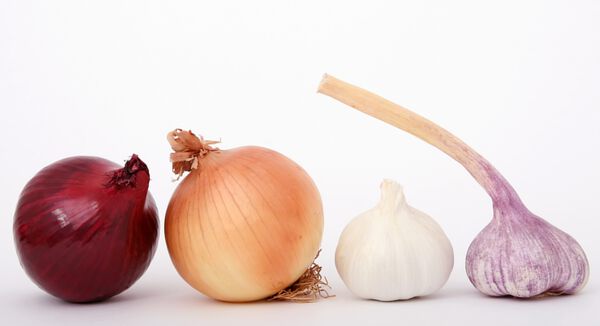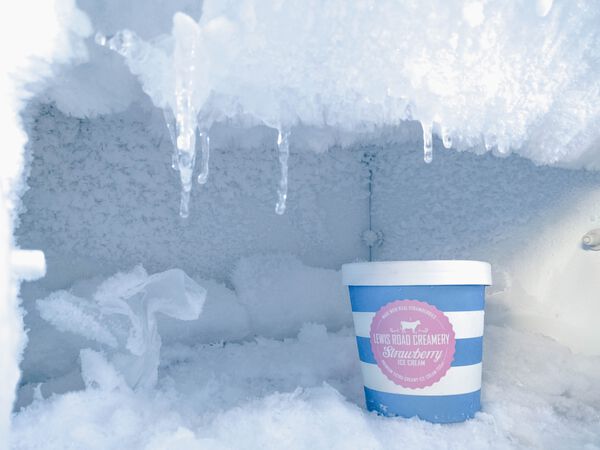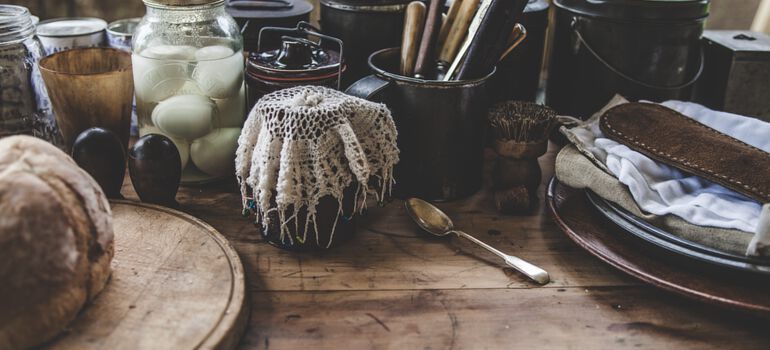For many off gridders, growing and hunting the food is the fun part but the real challenge begins when you try to store it for later. Nature dictates that food is much more plentiful part of the year, and so those who wish to live freely and independently from the industrial food system need to know how to stock up their pantry for good eating all year long.
How can I preserve food off grid? Our ancestors used a wide variety of techniques to store their food, including:
- Canning
- Smoking / Salting / Drying
- Pickling / Fermentation / Vinegar
- Root Cellar
- Dry Storage
- Cold box
- Chest freezer on off grid power
- Suet / Fat Storage
- Wood Ashes / Slaked Lime
- Honey
Following along while I hit the highlights of these off grid and low cost food storage techniques.
Basics of Off Grid Food Storage
Food storage is really the business creating conditions where the food you worked so hard to grow and gather will not spoil and can be used for months and months. Bacteria, fungus, and molds that work against preservation can be stopped or slowed down by one or more of the following conditions:
- Too hot / too cold
- Too acidic / too basic
- Too sweet / too salty
- Too dry
Every traditional food storage method uses one or more of these conditions to preserve harvests for later use, except for naturally long lasting crops like squash and some types of apples.
Canning for Off Grid Food Storage
Canning is probably the first thing people think of when they consider storing food for the long term use. This method requires:
- Glass jars with lids,
- A canner or pressure cooker
- A good book of canning tables like the classic ball “Blue Book” which is no longer blue
Unfortunately, traditional metal canning jar lids are considered a one-time-use item, and are recommended to be replaced every year. However, there are “indefinitely reusable” canning lids on the market.
Canning works on the theory of locking partially cooked fruits, vegetables, meats, jams, soups, or even milk in a air tight jar. Then the jar is boiled long enough to kill anything inside that could spoil the contents.
The most important safety concern when home canning foods is Botulism, which is a rare disease caused by Clostridium botulinum and related bacteria. These bacteria grow well in low oxygen conditions like the inside of canning jars, but can’t handle acid, sugar, or salt. Because of this, some foods like jam and salsa can be safely canned in a just boiling water. However, many vegetables, meats, and soups must be sterilized in the higher temperatures of a pressure cooker to be certain of their safety.
When canning, always follow the directions of a source that you trust, such as the Ball Blue Book. In the US, most state colleges offer free canning information and pressure cooker testing through their extension service.
Smoking, Salting, and Drying
Smoking, salting, and drying are techniques commonly used with meats, but can also be applied quite well to a number of fruits and vegetables.
The idea behind these methods is to generally reduce the moisture content of the food so low that spoilage won’t happen. In addition, smoking and salting create acidic or salt conditions in the food that also inhibit growth. This is different than pickling, which is salty but wet (more info below).
Salting generally needs a cool, dry area where the meet can cure. This can be up in the rafters of a house or barn, in a special room, or an out building built for the purpose.
Smoking also requires a smoke house or smoker that applies the smoke. There are two ways to smoke meat — hot smoking and cold smoking. Hot smoking also cooks the meat, and is not usually used as a storage technique. Cold smoking just soaks the uncooked meat in cool smoke, but are often also “cured” with preservatives in modern times. Traditionally, preservatives were not added.
The process of salting and smoking also helps to dry the meat because the salt draws out water, and the smoked air is already dry and helps to speed up the process. For fruits and vegetables, application of direct but low heat helps the drying process. Methods include:
- Just on a table in the Sun
- Solar dehydrator
- Low oven
Traditional Sun Dried Tomato Paste
Pickling and Fermentation
Pickling and fermentation techniques rely on the competitive action of “good” bacteria to drive out other, potentially dangerous varieties. Common fermented foods include:
- Sauerkraut
- Kimchi
- Kombucha
- Miso
- Pickles
- Cheese
- Vinegar
- Beer and wine
Pretty much any vegetable can be fermented in the traditional way. This is the method of “lacto-fermentation,” but is really the same thing as sauerkraut and pickles.
How to Ferment vegetables
- Make a brine by adding 1-3 table spoons per quart of water
- Tightly pack the vegetables in a jar and cover with brine
- Let sit for 1-2 weeks in a cool spot out of the sun
Sauerkraut
Sauerkraut is similar to the above, except you add the salt directly to the grated cabbage at a radio of 1 tablespoon of salt for 1.75 pounds of vegetables. Crush the cabbage after adding salt with hands (or feet traditionally). This should release enough moisture to fully cover the tightly packed cabbage after 15-20 minutes, but you may add a small amount of brine if necessary to makes sure all the kraut is covered.

Root Cellars and Dry Storage
Some foods can be stored in a cold damp room, often called a root cellar because many root vegetables can be preserved there. They can be as simple as a hole in the ground near by on under the house. Foods that work will in a root cellar include:
- Apples
- Beets
- Broccoli
- Brussels Sprouts
- Cabbage
- Carrots
- Artichokes
- Leaks
- Parsnips
- Pears
- Potatoes
- Rutabagas
- Turnips
- Radishes
Dry storage is just dry room or pantry that stays relatively cool. Dry storage works well with:
- Any dried beans
- Garlic
- Onions
- Pumpkins
- Squash
- Sweet potatoes
- Grains
- Tomatoes
(source)
Simple Off Grid Refrigeration — the Cold Box
Cold is the most common way that we store food today. Pretty much anyone in a developed county would feel out of place in a home without some form of refrigeration.
Before ubiquitous electric power, several low-tech alternatives existed. The simplest was a well insulated “cold box” that had small opening to the shady side of the house. This would allow access to the coldest air in the summer, and functioned as a moderate place to store perishable foods. Off course, in the winter, cold weather naturally help preserve foods, but the cold box could be a place to store foods so they would be colder than the kitchen, but not so cold as to freeze.
Low Cost Ice Box
A step up in comfort, and also complexity, is the ice box. Ice boxes have been around for hundreds of years, and simply consist of an insulated box with a place to put a block of ice. Essentially a more permanent cooler. Before electricity, the ice came from an ice house in which ice from the winter would be packed and stored all year long. In cooler climates, this ice often came from a local lake, but farther south it could be shipped in from the north.
A modern ice house could cheaply be constructed as a very well insulated shed. The modern homesteader who lives in a northern climate could easily freeze large cubes of ice outside over the winter, and store them for use throughout the summer. Larger blocks, as large as you can handle, store the longest because they melt more slowly.

Low Cost Off Grid Chest Freezer
Certainly with off grid electric systems, modern refrigerators and freezers are possible while living off grid.
However, with off grid solar a low cost chest freezer or two make a good thrifty alternative. Chest freezers are very efficient, and can be beefed up with extra insulation by a handy homesteader. Plus, they match very well with off grid solar, since freezers need more power when the sun is shining, and that’s when solar panels have power to spare.
For a high efficiency off grid refrigerator, you can use an extra chest freezer. With a simple themometer controlled outlet like this you can convert your discount Craigslist chest freezer in to a very efficient refrigerator with precise temperature control.
Other Traditional Methods
There are a wide variety of methods to store individual food items such as coating them in non-rancid fat such a suit, covering them in ashes, candying them in honey or emerging them in slaked lime (a product of limestone and sea shells).
Watch the video below to see how some of these methods can be used to store fresh eggs for months at a time without refrigeration.
A Note on Modern Preservatives
If you have been reading food labels in the last fifty years you will probably have seen a number of potetntially harmful food additives and preservatives listed there. Modern preservatives work to kill corrupting bacteria, and operate as a poison that is supposedly too dilute to harm the human who consume it.
Examples of modern preservatives include:
- Sodium Benzoate
- Sodium Nitrate and Sodium Nitrite (aka “curing salt”)
- Sulfur Dioxide
- Propyl Paraben
- BHA and BHT (aka butylated hydroxyanisole and butylated hydroxytoluene)
Because modern preservatives are the product of the industrial chemistry system, and not readily producible in a homestead, I will not cover theme in depth here
One thing to note is that sodium nitrate / nitrite are commonly used replacements for potassium nitrate (saltpetre) and is essential to the texture and flavor of cured meats. There are historical methods of making saltpetre from ashes and urine, so this may possibly be a homestead friendly preservative. But, I won’t go in to that here.
Related Questions
What food can you preserve?
Almost any food can be preserved in some for, whether frozen, canned, dried, or fermented.
How did they preserve food in the old days?
Old timers used a variety of techniques including canning, drying, salting, smoking, storage in ashes, lime water, wheat husks, root cellars, and dry storage. Same areas kept ice from the winter in an ice house for low-tech refrigeration.
How did our forefathers preserve food without a refrigerator?
Our forefathers used a variety of techniques including:
- canning
- drying
- salting
- smoking
- storage in ashes
- lime water
- root cellars
- dry storage
- ice houses / ice box


